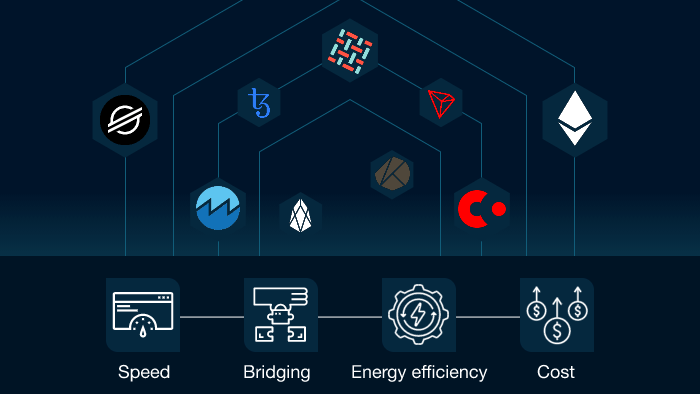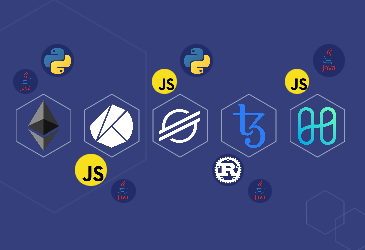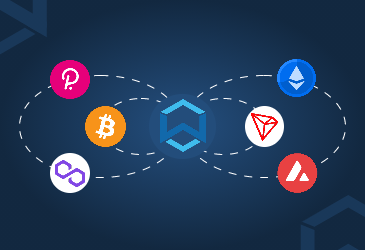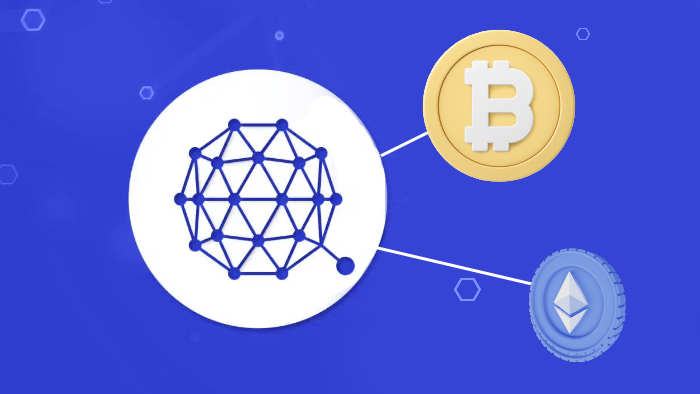
How to Choose a Blockchain Protocol Suitable to Your Project?
Blockchain technology has gained widespread popularity and has been implemented in many industries, including healthcare, education, e-commerce, finance, and manufacturing. The market for blockchain is expected to reach 68 billion USD by 2026 due to the widespread adoption of blockchain across various industries. However, the growth of blockchain has also led to the development of many different blockchain protocols, making it difficult for companies to choose the best one for their needs. Each protocol has its own unique strengths related to interoperability, speed, scalability etc. Determining which protocol best fits a company’s size and needs can be challenging for blockchain-based projects.
This article will help you understand the criteria for blockchain protocol selection and how Scortik can help you choose the right protocol for your development needs.
Different types of blockchain protocols
Blockchain protocols are the rules and standards that govern the operation of a blockchain network. They define how the network functions, including how data is recorded, validated, and stored on the blockchain, as well as how participants on the network can access and interact with the blockchain. Different blockchain protocols have been developed to support different use cases and have varying features and capabilities. Some examples of blockchain protocols include Bitcoin, Ethereum, Hyperledger Fabric, and Corda.
There are three main types of blockchain protocols:
- Public protocols
- Private protocols
- Hybrid protocols
Pubic protocols
These are open-source, permissible blockchains that anyone can access and benefit from. This means that anyone can download and launch a node to join the network. Ethereum is a public protocol that allows users to create and manage smart contracts. Anyone can create a decentralized application (dApp) on Ethereum by purchasing Ether to fuel their software programs. Stellar and Bitcoin are other public blockchain protocols with highly distributed and immutable benefits. Once verified, the data can not be altered. It fosters trust and transparency among its participants but comes at the cost of efficiency and price because of its long and energy-intensive verification process.
Private protocols
Unlike public protocols, private blockchain protocols require authorization to access. They also function under the appearance of a centralized organization. The options for granting access to the network include allowing participants to nominate future members or requiring a user to complete a set of predetermined tasks before being granted admission. An entity can join the network to help with the decentralized maintenance and upkeep of the blockchain. The system is based on internal players validating transactions. There are no game-theoretic incentive structures to protect the network. While private blockchains have a higher efficiency in terms of scaling and compliance with legal norms, they are more susceptible to network manipulation.
Hybrid protocols
They combine public and private protocols. IT professionals can use both private and public chains to develop a hybrid project. Although some information can be stored on private chains, consensus can be reached on a public chain for a different set. It is also known as a hybrid protocol.
Importance of blockchain protocols
Blockchain protocols are important because they provide the foundation for the operation of a blockchain network. They define the rules and standards that govern the network, ensuring that it functions in a consistent and secure manner. Blockchain protocols are also important because they can influence the scalability, security, and privacy of a blockchain network. Different protocols have different features and capabilities, and choosing the right protocol for a particular use case can be crucial for the success of the network. In addition, blockchain protocols can have a significant impact on the overall adoption and growth of the blockchain industry, as they can determine the kinds of applications and services that can be built on top of a particular blockchain platform.
When building blockchain development projects, you should first consider the choice of protocols. This will affect the functionality of your application. The most complex projects require the cooperation of thousands of computer scientists. Instead of reinventing the wheel, a protocol allows you to complete your project faster and with fewer resources.
Factors to consider when choosing a blockchain protocol for development
Speed
Speed is an important factor when choosing a blockchain protocol. For example, Solana is considered an “Ethereum killer” due to its capacity for high transactions per minute, while Bitcoin, due to its high energy consumption, can only process a limited number of transactions per second. You must decide whether high-speed transactions or slower, more expensive and less energy-consuming ones are necessary. It is important to understand the impact speed has on your application. But can speed be detrimental? You may not be able to access the other features your project needs if you only choose a faster blockchain protocol. So, ensuring you choose the right speed is important.
Bridging
Bridging allows users to transfer assets and money between protocols in a flexible way. When you are considering building a blockchain project, you should consider the compatibility and bridging support your blockchain protocol could provide. There are also bridging-focused protocols like Polygon and Polkadot. Para chains and side chains are used in these protocols to allow developers to create applications that can bridge with multiple protocols. Bridging is an important part of the development process. It allows you to move your application to other protocols as the protocol evolves.
Energy efficiency
While the energy efficiency of blockchain protocols has been extensively discussed, it seems that businesses ignore this fact when creating blockchain applications. Energy has a major environmental impact. Therefore, it is crucial to look at energy-efficient blockchains to make the blockchain sustainable. Ethereum used to adopt the proof-of-work consensus mechanism, which is inefficient and costs more. In order to make Ethereum’s blockchain more eco-friendly, Ethereum has now migrated to the proof-of-stake consensus algorithm, which is 99.95% more energy efficient.
Cost
The cost of the protocol is another important consideration. It is heavily dependent on the consensus algorithms used. Common consensus methods include proof-of-work, proof-of-stake and proof-of-history. PoW is the most costly, but PoS and PoH are superior. For PoW, it is a competition between miners against one another to complete the confirmation. This requires a complex mathematical puzzle, computing power, and crypto rewards. PoS and PoH don’t require miners to solve complicated mathematical puzzles to secure transactions. PoS uses a staking mechanism that involves economic incentives to protect network security. However, PoH uses a cryptographically secure function to generate the output. They are, therefore, more efficient ways to reach a consensus.
Choosing a blockchain protocol based on your use case
The constant emergence of new protocols and the maturity of existing ones can make it difficult to determine the best choice for your project. To make an informed decision, it is important to consider the specific needs of your application. Understanding the type of application you want to develop and the requirements it has can provide valuable insights into which protocol would be most suitable. This way, you can ensure that you choose a protocol that meets your application’s needs and supports its development.
Decentralized finance
Decentralized finance, or DeFi, is a financial system that operates without central intermediaries, using smart contracts on a blockchain to regulate financial transactions. These smart contracts can replace traditional financial intermediaries like banks, brokerage houses, and loan systems. In a DeFi system, users can earn returns by staking their crypto assets, similar to the way that depositing money in a bank can earn interest.
From a development perspective, DeFi applications have different requirements depending on the specific use case. For example, a DeFi lending app will need a high-speed blockchain protocol to facilitate real-time transactions, while a DeFi staking application may not require such immediate recording of transactions. Exchanges are another popular DeFi use case, with both centralized exchanges controlled by a central entity and decentralized exchanges powered by smart contracts.
Decentralized storage
Decentralized storage is a popular use case for blockchain technology, with applications operating at different layers of the technology stack depending on the specific requirements. Cost optimization in terms of space and time is an important consideration when building decentralized storage systems, as there is the complexity involved in storing, retrieving, and executing business logic on data stored on a blockchain network. There are several different types of decentralized storage applications, including IPFS, which operates at the first layer, and applications like FileCoin and Store, which are built on top of IPFS and add additional features.
Value chain
A value chain is a type of blockchain use case that is particularly relevant for enterprise settings where multiple entities are involved in business processes. By using a blockchain-based value chain, these entities can participate in a trustless manner, using their nodes to contribute to the consensus mechanism. An example of a value chain application could be an end-to-end medical aid distribution network, where multiple entities are involved in procuring and transporting aid from one country to another. By participating in the blockchain consensus mechanism, these entities can ensure complete transparency, traceability, value exchange, and smooth flow of cross-organizational processes. Value chain systems are typically built on permissioned blockchains rather than public or private chains.
NFTs
Non-fungible tokens (NFTs) are a growing use case for blockchain technology, allowing the tokenization of digital assets such as art, music, in-game assets, and more. NFTs provide immutable proof of ownership for these digital assets and have gained widespread adoption. To support the buying and selling of NFTs, blockchain protocols are needed to build NFT marketplaces. However, the protocol itself does not play a central role in the functioning of NFTs, which primarily involves record-keeping and triggering the appropriate business logic when values change hands. For this reason, NFT applications require compatibility with smart contracts and storage facilities, although many protocols do not have built-in storage capabilities.
Another challenge with NFTs is the validation of the underlying assets. When a user buys an NFT, they want to ensure that it is unique and not available elsewhere. This requires solutions for fraud prevention and validation. Overall, applications that involve record-keeping, such as NFT transactions, and legal, health, and educational records, have different requirements that may involve private or permissioned blocks, with data being updated and synchronized with third-party sources.
Legacy systems
There are a lot of applications out there that are centralized. Also, a lot of data is stored on centralized databases or centralized storage systems. So, how can blockchain technology be introduced to those legacy systems?
In this particular type of use case, any important data from legacy systems that need validation are pushed to the blockchain and stored on it. One of the key technical requirements in such use cases is offline or on-chain and off-chain data synchronization. Here the requirement is a quality protocol that can handle a lot of on-chain and off-chain data synchronization.
Metaverse
The concept of metaverse, a digital world where users can chat, interact, and exchange value through their digital avatars, has long been a feature of gaming platforms like Minecraft and Roblox. However, metaverse is now expanding beyond gaming and finding relevance in a range of other digital experiences, including work, networking, and travel. The adoption of metaverse and beta version gaming will be a major use case for blockchain technology, with marketplaces already being created to buy digital assets for virtual worlds.
One key aspect of metaverse as a blockchain use case is the need for strong interoperability between different digital spaces. While Facebook’s recent announcement of its metaverse plans suggests the possibility of a centralized metaverse, there will likely be many different metaverses, with interoperability between them facilitating movement from one digital space to another. To support the development of metaverse, the underlying protocol will need to be strong in terms of interoperability.
How can Scortik help you choose the right blockchain protocol?
Scortik is a comprehensive resource for developers working within the web3 ecosystem, providing an objective evaluation of various protocols, tools, and technologies. It offers a 360-degree overview of a protocol’s developer ecosystem, including metrics such as write and read speeds, gas fees, developer support, and GitHub engagement. This helps developers to make informed decisions about which protocols, tools, and technologies to use in their projects. Scortik is also a protocol rating and review platform that gives you a comparative overview of 38 top blockchain protocols along with live monitoring. Scortik provides protocol details and offers the scope of learning to users through its insights and developers section for each protocol. Users can acquire in-depth knowledge of a particular protocol by going through these sections.
Endnote
In conclusion, choosing the right blockchain protocol for your project can be challenging. There are a number of factors to consider, including the scalability, security, and degree of decentralization of the protocol, as well as the specific requirements of your project. One useful approach is to use a tool like Scortik, which offers a comprehensive overview of the developer ecosystem for various protocols, including metrics such as the ones mentioned above. Evaluating these factors allows you to decide which protocol is most suitable for your project. It is also important to keep in mind that the blockchain landscape is constantly evolving, so it is essential to stay up-to-date on the latest developments and choose a protocol that can meet the needs of your project now and in the future.
If you want to learn about the blockchain protocols performance and technical details, you can check out Scortik for protocols rating and review.
Insights

What are SDKs? Top blockchains and their SDKs
A software development kit or SDK is a set of tools and programs utilized to build and integrate customized applications for any existing or new platform.

WanChain: Empowering Blockchains With Interoperability
Wanchain is a blockchain interoperability and decentralized finance platform that connects multiple blockchains with one another.

Qtum- Producing the best From Ethereum and Bitcoin
This insight describes all the technical details of Qtum blockchain.